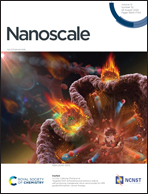Three-dimensional rope-like and cloud-like nanofibrous scaffolds facilitating in-depth cell infiltration developed using a highly conductive electrospinning system†
Abstract
Three-dimensional (3D) nanofibrous scaffolds are at the forefront of tissue engineering research. However, owing to the compact geometries or unstable reserved pores, the scaffolds produced by the current techniques provide limited in-depth cell infiltration, leaving the regeneration of 3D tissues a major challenge. Herein, we have developed a novel single-step 3D electrospinning technique to create 3D rope-like or cloud-like nanofibrous scaffolds by introducing 0 to 0.9 wt% of silver nanoparticles (Ag NPs) into a spinning system and provided an insight into the mechanism. The incorporation of Ag NPs caused intense jet whipping and elevated fiber conductivity, allowing reverse charge transfer and segmented charge storage to provoke vertical collection of waved spirals. The resultant scaffolds exhibited ultrahigh specific pore volumes, facilitating in-depth cell attachment, migration, and proliferation. This work demonstrated a feasible approach to establish versatile 3D culture nanofibrous platforms for a variety of biomedical applications.



 Please wait while we load your content...
Please wait while we load your content...